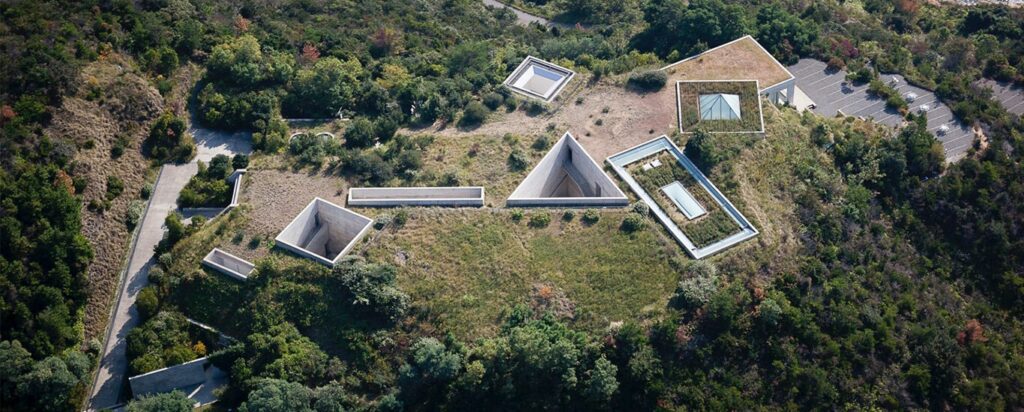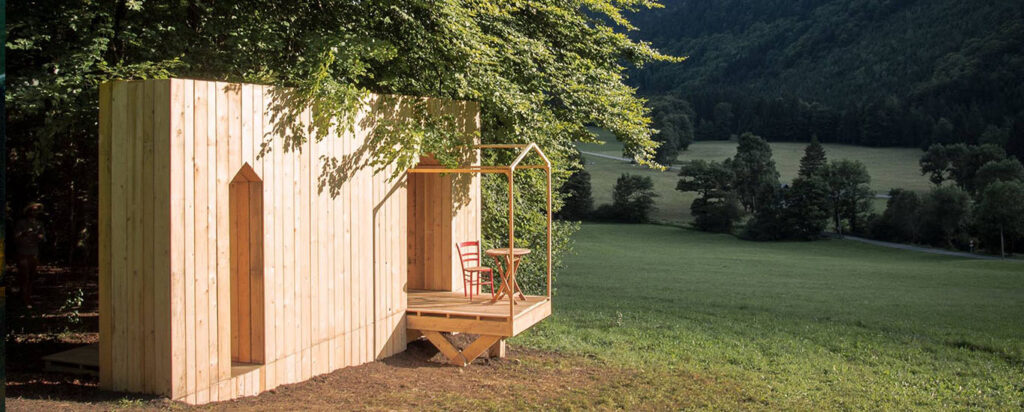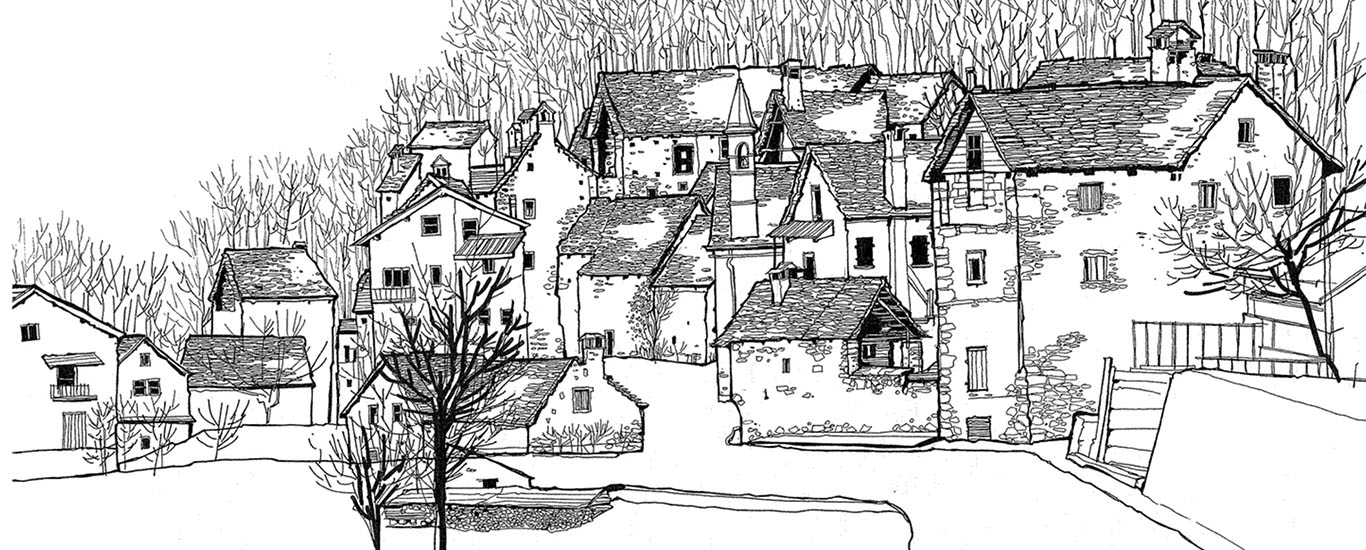
The Teshima Art Museum (above) in Naoshima, Japan brought economic prosperity to a
small island in decline. Photo from https://benesse-artsite.jp/en/
Illustrations of Relationships Between Architecture and Tourism.
Editor for this page: Clara Copiglia
This page collects lessons about the impact of architectural projects on place-making, restoration, or recovery. These projects range from small installations to larger strategies that impact the surrounding territory – territory is defined here as the context of the project, its environment, community, culture, and economy.
We invite you to help expand its content.
Larger themes – depopulation, nature appeal, indigenous communities, ruins care, and overtourism – frame the various case studies below. An example illustrates each category. You can find an extensive collection of such examples here.
Depopulation
Architecture can become a tool against depopulation. Renovations or new construction projects can revive rural or urban destinations in decline when they integrate the local community, landscape, and an understanding of local history.
Rural Example – Naoshima Island, Japan

Naoshima, a small island in the Seto Inland Sea, experienced drastic population loss in the 1960s. At the same time, a wealthy businessman was looking for a home for his art collection. He hired Tadao Ando, a world-famous architect, to build a museum on Naoshima. Today, Naoshima Island is a major art destination, where visitors cruise on electric bikes and local life has return. The island now has multiple new museums and art installations. Renovated traditional buildings house a bathhouse, restaurants, accommodations, and art. But Naoshima was only the beginning of the Seto sea island’s transformation. Other Islands, such as Teshima and Inujima, followed Naoshima’s path.
Urban Example – MassMoca, United States

Once a thriving manufacturing town with an increasing population, the mill town of North Adams, Massachusetts, faced financial trouble in 1984 with the shutdown of local companies. Thomas Krens, the director of Williams College Museum of Art (who later became Director of the Solomon R. Guggenheim Museum), was looking for a space to exhibit large contemporary art pieces. North Adam’s mayor proposed an empty factory in the town, and in 1999, the world’s largest contemporary art museum was born. Today, North Adams revolves around art, and MassMoca (Massachusetts Museum of Contemporary Art) brought economic prosperity and tourism.
Nature Appeal
Architectural projects can invite visitors to step into nature by creating new attractions. The project can create a new path in nature or sit along an existing path, reviving it.
Example– Festival des Cabanes, France

The Festival des Cabanes – Small Pavilions Festival– is an annual architecture event near Annecy, France. Every year, architecture students and young architects participate in a competition to construct 12 wooden pavilions spread out in the area south of Lake Annecy. Each pavilion stays from Spring to Autumn and is dismantled at the end of the exhibition. The festival invites visitors to this natural region instead of limiting tourism to the popular lakeshore. Equipped with a map, the visitors walk in nature to reach the pavilions constructed by the competition’s participants. This festival gives a unique opportunity for young architects and brings tourists to rural areas.
Indigenous Communities
Some projects can create a meeting place between indigenous communities and visitors, where tourists can learn about local traditions and history. The indigenous community should set the intentions of the project.
Example – Krakani Lumi, Australia

Krakani Lumi – Place of Rest – is a series of pavilions on a guided walk in Tasmania. The palawa community owns the land and operates the 4-day/3-night journey called the ‘wukalina walk’. The architects collaborated with the Aboriginal Land Council of Tasmania to create unique campsites where visitors can rest and learn about traditions. The tectonic and materiality of the project pay homage to the First Tasmanians and their land. The exterior of the pavilions is made of charred Tasmanian timber to blend with their surroundings. The architects had the buildings prefabricated off-site to minimize impact on the land.
Ruins Care
Due to financial and political constraints, many ruins are difficult to maintain and renovate. Adaptive reuse projects or participatory tourism provide sustainable strategies to care for ruins.
Example – Canova Association, Italy

The Canova Association is a nonprofit founded in 2022. Its goal is to bring awareness to stone architecture in Nava, Italy. In collaboration with the municipality, the association facilitates acquiring and restoring the small medieval village’s stone buildings. The non-profit organizes guided tours for tourists to discover the village, events for its members, and workshops dedicated to architectural restoration.
Overtourism Mitigation
Overtourism is the opposite of sustainable tourism. Various policies help resist this scourge, and architectural or territorial interventions can also be part of the solution by creating alternative paths and attractions.
Example – Alternative Moray, Peru

The AA Nanotourism Visiting School is a teaching program developed by the Architectural Association, School of Architecture, London, UK. Each year, they organize workshops with architecture students and young architects about sustainable tourism. In 2019, the workshop took place in Moray, one of Peru’s most popular Inca sites. The students collected the community’s history and proposed an alternative path for visiting Moray. Small installations invite visitors to get away from the touristic route to learn about the local community and participate in activities.
 Page editor: Clara Copiglia, architectural and urban designer whose work intersects communities, rural tourism, and architecture. Currently based in Zurich, she’s deepening her expertise in regional development within Switzerland.
Page editor: Clara Copiglia, architectural and urban designer whose work intersects communities, rural tourism, and architecture. Currently based in Zurich, she’s deepening her expertise in regional development within Switzerland.
